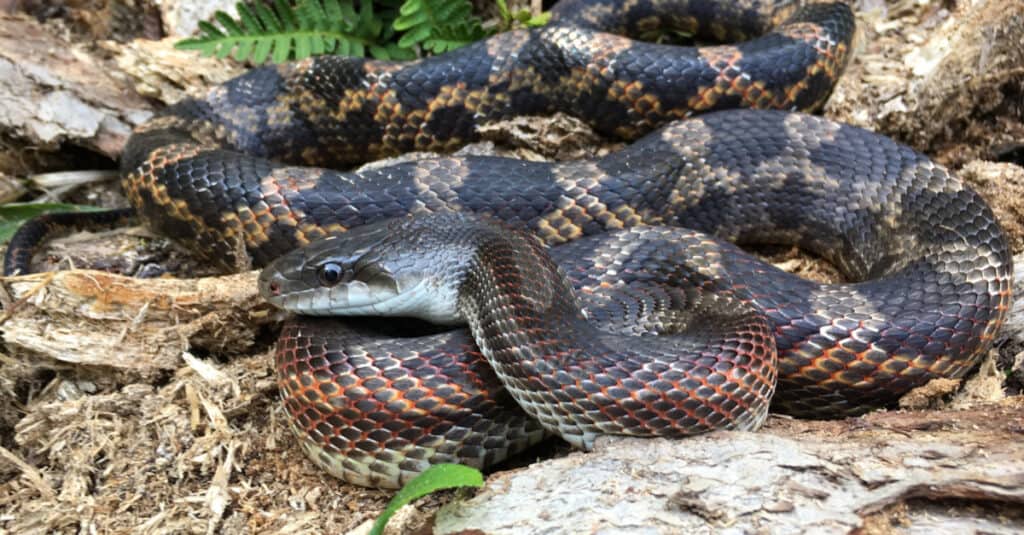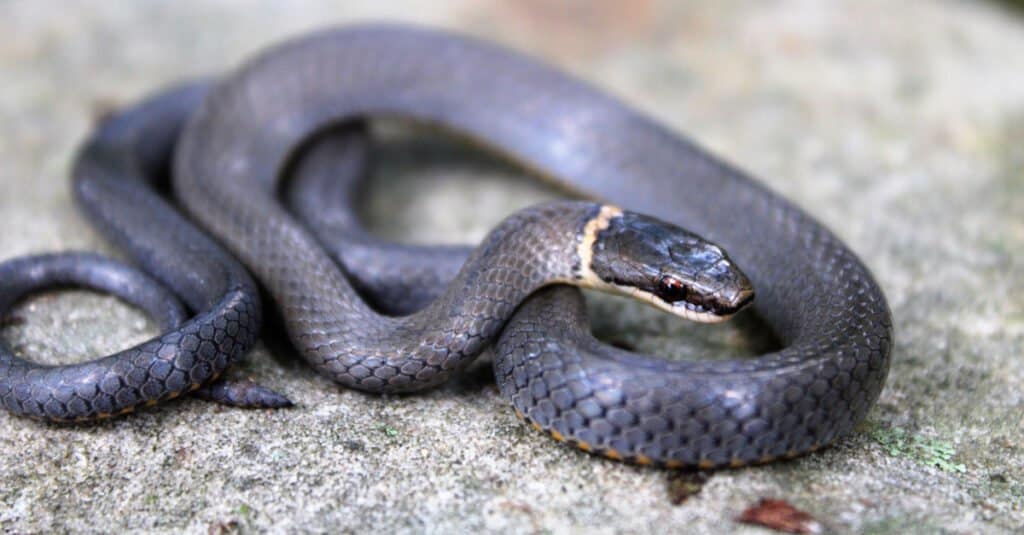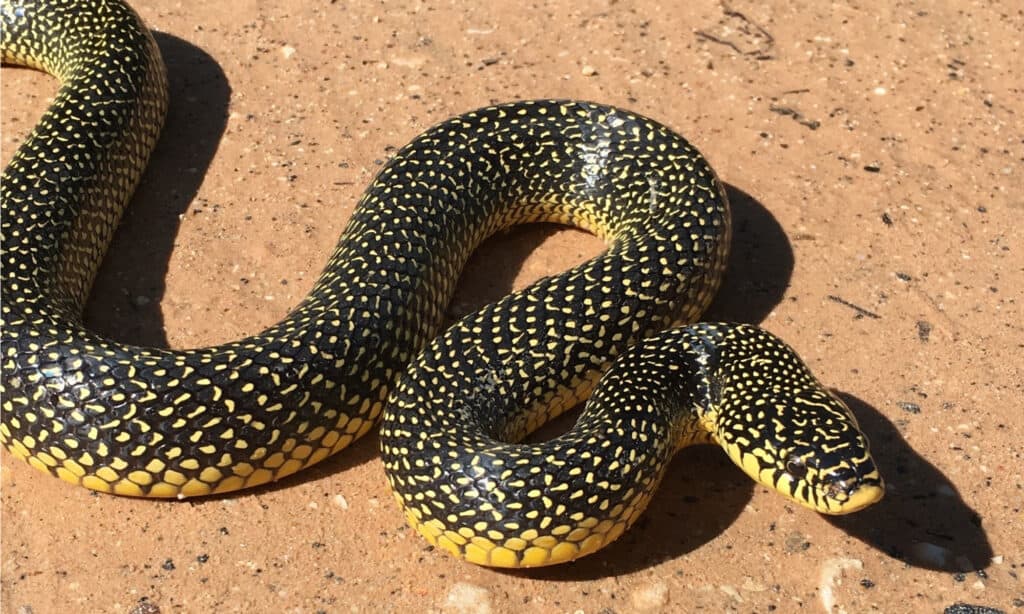Arkansas, also known as the Natural State, has 52 state parks, five national parks, and three national forests. It’s known for its wildlife, and the wilderness is still prevalent through those parks and forests. Wherever you have gardens, parks, and forests, you’ll probably find rodents and small mammals; those small animals bring predators like snakes. Although most of these slithering little reptiles that make their way into your garden aren’t dangerous, some are. Knowing how to identify garden snakes in Arkansas is vital, so that’s where we begin!
Most Common Venomous Snake in Arkansas: The Northern Cottonmouth (Agkistrodon piscivorus)

Cottonmouths are venomous snakes.
©Marcum Havens/Shutterstock.com
The most common venomous snake in Arkansas is the northern cottonmouth, also known as the water moccasin. This pit viper is the biggest species in the Agkistrodon genus and one of the most common venomous snakes in the southeastern United States. These snakes typically measure between three and six feet long, with stout bodies typical of pit vipers.
Cottonmouths often have a dark stripe that starts right behind the eye and continues toward the jaw, but it isn’t always present. As juveniles, they have brighter patterns, and people often confuse them with copperheads. These snakes’ base color varies and can be tan, brown, or reddish brown with darker crossbands that sometimes look like chocolate kisses with jagged edges from the side. However, the pattern fades as they age, and the snakes become almost uniform in color, with the barest hints of pattern near their bellies.
Cottonmouth snakes are also called water moccasins, swamp moccasins, Texas moccasins, gapers, and about 20 other common names. These snakes prefer wetlands, swamps, and rivers with plenty of fish, frogs, and toads to eat. They’re semiaquatic and are most at home in the water.
These snakes get a bad name not because they’re aggressive but because they’re more likely to stand their ground than rattlesnakes. Cottonmouths are pretty cumbersome and slow on the land, so they take longer to get away. They rely heavily on their camouflage and really hope you don’t see them. When you surprise one, it’s likely to gape its mouth at you, showing you why people call it a cottonmouth — its cotton-white mouth.
Eastern Copperhead (Agkistrodon contortrix)

Copperheads are venomous snakes in Arkansas.
©Jeff W. Jarrett/Shutterstock.com
The second-most common venomous snake in Arkansas is the eastern copperhead. Although they’re in the Agkistrodon genus with cottonmouths, copperhead snakes aren’t semiaquatic. Instead, they prefer the forests and edges of gardens where the leaf litter perfectly hides them.
Copperheads are smaller than cottonmouths, at only two to three feet long on average, and maintain their banded or chocolate kiss pattern throughout their lives.
They have chunky bodies like other pit vipers, with large heads set on skinny necks. Copperheads’ eyes have vertical pupils and the extra scale over them that gives pit vipers their distinctive cranky expression. Their pattern is a series of crossbands or hourglass shapes over a lighter base color, miming the shape of the fallen leaves where they hide.
Other Venomous Snakes in Arkansas
Cottonmouths and copperheads aren’t the only venomous snakes in Arkansas — they’re just the most common.
- Timber rattlesnake (Crotalus horridus)
- Pygmy rattlesnake (Sistrurus miliarius)
- Western diamondback rattlesnake (Crotalus atrox)
- Texas coral snake (Micrurus tener)
Most Common Nonvenomous Arkansas Snake: The Western Ratsnake (Pantherophis obsoletus)

Western rat snakes come in many colors but darken with age and lose some of their patterns.
©Joe Farah/Shutterstock.com
Now that you can identify the venomous snakes, it’s time to take a look at the nonvenomous snakes you may encounter. The most common snake in Arkansas is the western rat snake, which is also nonvenomous. This is partly because they’re not shy, and partly because you’re more likely to find a rat snake in a ridiculous place.
Rat snakes of all kinds are common across the eastern half of the United States. They’re adept climbers, and if you’ve seen photos of snakes in bizarre places, there’s a good chance it was a rat snake. They climb up the grout lines in a brick wall, cruise through garage rafters, and slither through the trees, all while on the hunt for their favorite food — rats and mice. These snakes startle many unsuspecting people!
Young western rat snakes have lighter base colors with darker, sometimes shield-shaped blotches down their backs. A few localities maintain their pattern throughout their lifetime, yet most rat snakes become nearly black as they age. Even the darkest rat snakes have a lot of white on their chins and necks; they also have vertical stripes extending from their lower jaw upward, called labial bars. These diurnal snakes have round pupils and longish heads attached to long, thin bodies. They are usually between three and six feet long, but the record length was eight feet, five inches. Western rat snakes can move quickly, although not quite as fast as racers.
Ring-Necked Snake (Diadophis punctatus)

Ring-necked snakes are tiny and only reach about 18 inches long as adults.
©Tucker Heptinstall/Shutterstock.com
The ring-necked snake is technically a venomous species, but they lack actual venom glands, and it’s prey-specific — utterly harmless to people. They strike first, then hold their prey via constriction. After this, they work their mouth around their prey so its tiny fangs in the back of its mouth can puncture its skin. These snakes are highly secretive, and you may never see one unless you’re poking around rocks and under leaf litter.
Ring-necked snakes are tiny and only reach about 18 inches long as adults. These snakes almost never try to bite defensively. Instead, they coil their tail and show off their brightly colored belly. This species is a solid color that can be olive, bluish-gray, smokey black, or brown, broken by a single neckband that usually matches their bright belly color.
This and all other subspecies prefer moist soil, and most share communal dens. While they’re usually found in flatland forests and avoid our human-made structures, they’re not above using debris piles and the edges of our gardens.
Speckled Kingsnake (Lampropeltis holbrooki)

The speckled kingsnake has a glossy black body with whitish-yellow dots on its scales.
©Joe Farah/Shutterstock.com
Kingsnakes are common throughout most of North America. They prey on anything they can stuff in their mouths, and their diet includes other snakes. Speckled kingsnakes prefer wet habitats than other kingsnakes, and you’re more likely to encounter this snake in marshy areas with a lot of water. However, like the opportunists they are, they’ll also venture inland in search of prey — making you more likely to see one.
Speckled kingsnakes are more docile than some of the same regions’ racers. When they feel threatened, these snakes musk and bite; however, once captured, they only strike a couple of times and calm down quickly. Like other kingsnakes and rat snakes, speckled kingsnakes rattle their tails in the leaves like a rattlesnake. It’s a behavior that many believe is a form of mimicry. However, colubrids worldwide exhibit this behavior, so that seems unlikely.
These snakes aren’t giant and usually only reach about four feet. Their common name comes from their striking color — black with yellowish-white speckles. Some people call it the salt and pepper snake. Speckled kingsnakes are diurnal hunters and spend their days cruising through the underbrush, looking for a meal. If you see one, be rest assured that it can’t hurt you, and remember that they help keep the rodents in check.
Other Nonvenomous Snakes in Arkansas
Arkansas, while far from being full of snake species, still has a fair number of them. We’ve covered the most common snakes, and now, here are a few more:
- Dekay’s brown snake (Storeria dekai)
- Common garter snake (Thamnophis sirtalis)
- Four water snake species: Common water snakes (Nerodia sipedon), plain-bellied watersnakes (N. erythrogaster), diamondback watersnakes (N. rhombifer), and banded watersnakes (N. fasciata)
- Eastern hognose snakes (Heterodon platirhinos): These snakes are known for hilarious defensive displays.
The photo featured at the top of this post is © ButtermilkgirlVirginia/Shutterstock.com
Discover the "Monster" Snake 5X Bigger than an Anaconda
Every day A-Z Animals sends out some of the most incredible facts in the world from our free newsletter. Want to discover the 10 most beautiful snakes in the world, a "snake island" where you're never more than 3 feet from danger, or a "monster" snake 5X larger than an anaconda? Then sign up right now and you'll start receiving our daily newsletter absolutely free.
Thank you for reading! Have some feedback for us? Contact the AZ Animals editorial team.






